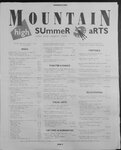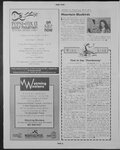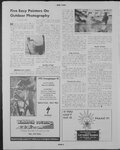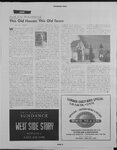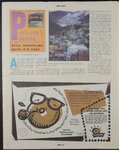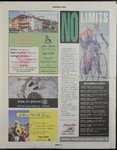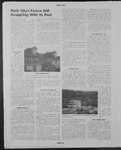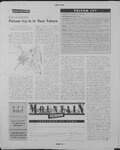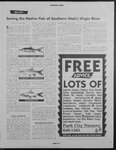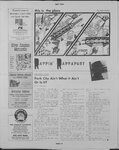| OCR Text |
Show ———————— ee ea JUNE SPECIES OF THE 1996 MONTH Poison Ivy: If You Go Outdoors Toxicodendron Also Known Poison Ivy Is in Your Future By Pamela Mills Poulson Manager of Environmental Education Red Butte Garden and Arboretum and hands. “Poison ivy! Wait a minute, I didn’t even see any of the stuff, let alone walk in it. And besides, I’ve been in poison ivy before and never had this reaction. What's going on here?” Gary, you can thank your playful, wallowing pal Maggie. The oils from the poison ivy were rubbed onto your legs and hands from her coat. She’s naturally immune and she just about lived in poison ivy all afternoon Gary’s allergic reaction was caused by a toxin suspended in the volatile oils of poison ivy, Toxicodendron rydbergii, whose scientific name literally translated is “Rydberg’s poison tree.” Around the world, many plants are called poison ivy, and most are close cousins in the same family: cashew, pistachio, A fluorescent orange disc lands gently among the thick, dark green foliage at the edge of the tumbling creek After it, a laughing black lab dives head first into the brush and comes up with the battered, Olympicsize Frisbee clenched tightly in her sumac, poison poison ivy. poisonous, Not but oak and all are contact with those that are tends to cause severe reactive dermatitis in sensitive people. If you to the stuff, think you are immune think again. Sensitivity can increase with continued contact. Interestingly, animals seem to be immune Technically, neither an ivy nor an oak, poison ivy is easily identified by its dark, shiny leaves — each divided into three leaflets across its range. The ‘leaves of three” characteristic holds fast, but the depth and distribution of teeth, serrations or lobes on each smiling face. She pauses briefly for a quick wallow in the shrubbery, then trots happily back to Gary, her master, waiting on the trail above. Still laughing, the furry playmate slides her sleek haunches across Gary’s naked legs, drops the Frisbee and begs for more— tail and tongue wagging. A both hearty, “good Maggie” scratch behind the ear, and Gary pitches Frisbee towards the creek once again. Later that night, Gary breaks out in a terrible, annoying rash. A million little scratchy bumps erupt on his calves leaflet is highly variable. Utah poison untoothed ivy has mostly smooth, rydbergii As: Poison Oak. Description: Deciduous shrub, climbing vine or woody perennial to 10 feet tall. Leaves 1 to 10 inches across, dark green, shiny and divided into 3 leaflets, with of without lobes or serrations. Flowers greenish yellow and inconspicuous. Berries globular, to 1/2 inch in diameter, white or yellow. ; Range: In all counties Alberta to Nova of Utah E 3,400 and 7,000 feet elevation. Texas and Virginia. Habitat: Whereever there is ample water to support it, usually in shade. Along streams, ponds, springs, quicksand, ditch banks and orchards, Cultural Notes: Eradicate it. Since it spreads vegetatively, mostly by suck- ering and rooting by small leftover pieces, the root system must be killed. Spray with a powerful herbicide and pull up by hand. Be sure to cover your skin completely and wear a respirator. TOXIC OILS ARE EFFECTIVE EVEN WHEN PLANT IS DEAD. NEVER BURN POISON IVY! Volatile oils become suspended in the smoke. Breathing poison ivy smoke can be fatal. First Aid: If contact is made, wash thoroughly with SOAP and water. Take an antihistamine immediately. If rash develops, wash frequently with soap and water. Apply antihistamine cream. Do not scratch. Spreads from open blisters. For treatment of internal injuries caused by eating the plant or breathing the smoke, get emergency care at once. edges. Also, the stature of the plant varies across its range. In different localities it grows as a woody perennial, a tall shrub or scrambling vine. In Utah, ours are short perennials, up to three feet high or vines hanging on other shrubs and trees. The most distinguishing characteristics of poison ivy are its acute branching and white berries, both good identifiers even in winter. Woody branches grow off the main stem at an angle of less than 30 degrees — a tighter angle than most other plants. The berries are whitish, and hang on translucent through the winter. The easiest time of year to spot poison ivy is in the fall, when it turns a beautiful bright maroon — not a hint of orange. This coloration is typical of the family and is the result of high concentrations of the pigment antho- play of maroon vining poison ivy. Only poison ivy grows in Utah. There is no poison oak or sumac in Utah. Poison oak is common in California and poison sumac (which looks just like our own, nontoxic cyanin, nous year round. Even rain or stream which intensifies in warm sunny autumns. Watch the mouth of Little Cottonwood Canyon and around the Old Mill for a spectacular fall dis- MAIL YOUR SUBSCRIPTION REQUEST TO P.O. BOX 1433 ¢ PARK CITY, UTAH 84060 OR FAX 801-649-8046 G between Scotia, south to Arizona, T With iT Squawbush, Rhus trilobata), is com- mon in the East and Midwest. Not only lay people and boy scouts are confused about the identification of poison ivy. The variation of leaf lobes and stature of poison ivy have developed much debate among botanists and taxonomists, to the point where every new variation is given a new species name. Poison ivy is as varied and is known by as many scientific binomials as dandelion. Another misconception is that only the leaves of poison ivy are toxic. Not so! All parts are filled with the volatile oil; consequently, the plant is poisowater that runs across the plant can deliver a rash. In 1984, during the river that was State Street period, sandbaggers who stood in the water building levies were afflicted with poison ivy rash on their legs. The toxin was water borne on the flood waters from City Creek Canyon — a canyon notorious for the preponderance of poison ivy. Look for poison ivy throughout Utah, wherever there is enough mois- ture to support it. Wasatch locations known for their patches of poison ivy Become One With ro Jin Oa: heats ila One | MA Gaia 3s “The High Altitude 12 ISSUES Alternative” Subscribe your issues $12.00 and Get delivered - 12 issues OF THE “TIMES” are City Creek Canyon, Red Butte Canyon, Big Cottonwood Canyon and Emigration Canyon. Watch for it all along the courses of creeks coming out of these canyons and along the Jordan River. Red Butte Garden and Westminster College have healthy ADDRESS. APT./ SUITE NO. CITY/STATE ZIP patches of it along the creeks there. It is also common on the drainages of THIS GIFT IS FROM PHONE NO. the ADDRESS APT/SUITE CITY/STATE CHECK PHONE VISAQ No Exp SIGNATURE NO. NO. Colorado River, and all across redrock country, where it grows in hanging gardens or adjacent to quicksand, and is common at Zion, Arches, Canyonlands and Lake Powell. @ |




